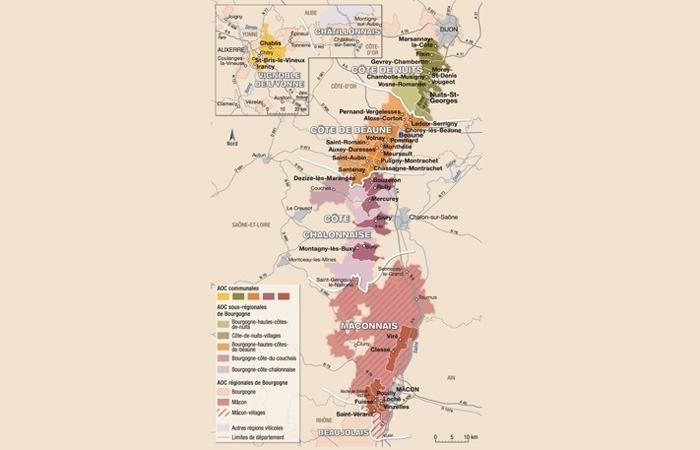Deciphering the appellations of the Bourgogne vineyard
27 November 2018
For oenology lovers, the richness of the wine is above all the diversity of the different grape varieties, white or red, and the specificities of the regions where the grapes flourish. The appellations are the literal translation of this complex universe, which combines the contribution of the vine, the influence of the terroir and the work of the winemaker.
For oenology lovers, the richness of the wine is above all the diversity of the different grape varieties, white or red, and the specificities of the regions where the grapes flourish. The appellations are the literal translation of this complex universe, which combines the contribution of the vine, the influence of the terroir and the work of the winemaker. But it is sometimes difficult to navigate, so many denominations can be difficult to address, especially in Burgundy, with its 83 appellations, spread over 4 levels – not to mention the climates!
A quick tour of the main appellations of Burgundy, to know a little better what we have in his glass.
The vineyard of Burgundy is divided into 4 levels, according to a classification by geographical origin.
Regional appellations
We start with the regional appellations which designate wines coming from the main regions of the vineyard. Distributed in 6 AOC, they allow to classify these wines produced on all the Burgundy territory according to precise characteristics (AOC Bourgogne Aligoté for the white wines produced from the grape variety of the same name, AOC “Crémants de Bourgogne” for sparkling wines, etc …). More than half of the Burgundy wine production is under this name.
“Village” appellations
Then come the communal appellations, wines attached to their villages of origin and AOC with evocative names like “Aloxe-Corton”, “Gevrey-Chambertin”, “Meursault”, “Pommard”, “Vosne-Romanée” or “Vougeot”. One-third of the wine production is devoted to it.
“Premiers Crus” and “Grands Crus”
Within these communal appellations is the first growth, which represents barely 10% of all wines in the region. They are easily identifiable because the name of the communal AOC from which the parcel is derived is followed by the name of a climate. We find here denominations that make the charm and history of the vineyards of Burgundy (“Sur le chêne », « Sous la Roche », « Les Pucelles », …).
Finally, the grands crus, the last level of reading that highlights the scarcity of these wines whose production is marginal (1 to 2% of the Burgundy vineyard). These are plots of only a few hectares in a climate, barely a few acres in some cases, but whose fame is international. Even those who have little or no interest in the world of wine will have already heard of “la Tâche », « Romanée-Conti », « Grands Echezeaux », « Corton-Charlemagne Grand Cru ».
Some details on the Climates
The Climates of the Burgundy vineyards have been highlighted recently since their entry into the UNESCO World Heritage. But finally, what is a Climate? A Climate is an area dedicated to viticulture, delimited geographically and precisely according to a cadastral plan, and this since the Middle Ages and the work of the monks of the region. The Climates are small parcels within the appellations and differ from each other according to many criteria such as the orientation of the slope, the nature of the soil and subsoil, the sunshine, sometimes a microclimate and often a history clean. There are 1463 climates listed on the whole vineyard of Burgundy. The goal is to be able to precisely link a wine to its exact place of production.
The 4 categories of appellations may mention a climate on their labels. In general, it should be noted that an AOC or a mention “Grand Cru” or “Premier Cru” is followed by the name of the Climate on the bottle.
Source : https://www.vinotrip.com/fr/blog/appellations-vins-bourgogne/
Find more infirmation on the following website : https://www.vins-bourgogne.fr







